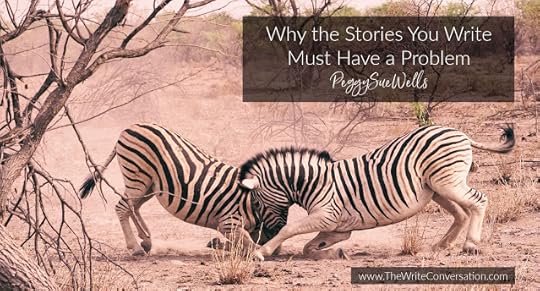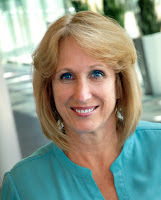Why the Stories You Write Must Have a Problem

by PeggySue Wells @PeggySueWells
To have a story is to have a problem. Story is conflict. Crisis. There must be a problem, an interruption to paradise, a discord in harmony. Without this essential ingredient, you have a description, but not a story.
One of my favorite writers experienced a traumatic life event. She naturally felt raw and vulnerable. This artist who also writes created a splendid make-believe land. At each writers meeting, we enjoyed our safe visit with the endearing residents. But before long, the listeners began to yawn. “Get a problem, Mary.”
The phrase remains a clarion call for authors.
We teach our children to be nice. Living in community, we are kind to others. When we put on our writer’s hat, we develop characters we care about. And because we care, we are tempted treat them kindly. This makes for a boring story at best. An author must consider the worst scenario and toss their beloved character head first into the exact situation we wish to protect them from.
Not:Will Stevie pass his spelling test?Will Ellie get a date to the prom?Instead:Will Steve Rogers protect America from nuclear destruction?Will Cinderella get to the ball and meet Prince Charming or perish in slavish obscurity?Readers learn about themselves as they observe your character react to worst case challenges. Our characters experience that transformative character arc because they were tested.
Former Pixar storyboard artist, Emma Coats outlined the basic story structure as a Mad Lib exercise.
Once upon a time, there was ______________________.
Every day, ____________________________________.
One day, ______________________________________.
Because of that, _________________________________.
Until finally, ____________________________________.
Fill in the blanks using your favorite stories. Now, fill in the blanks with your story ideas.
Author John Gardner explained conflict development this way. “A character wants something, goes after it despite opposition, and so arrives at a win, lose, or draw.”
Joseph Campbell described the story structure as a monomyth. “A hero ventures forth from the world of common day into a region of supernatural wonder: fabulous forces are there encountered, and a decisive victory is won: the hero comes back from this mysterious adventure with the power to bestow boons on his fellow man.”
In his book, The Hero With A Thousand Faces, Campbell outlined 17 stages of the monomyth which have been condensed into Call to AdventureInitiationReturnJerry Jenkins gives these essentials.An openerAn inciting incident that changes everythingA series of crises that build tensionA climaxAn endDan Harmon created a story circle.A character is in a zone of comfortBut they want somethingThey enter an unfamiliar situationAdapt to the situationGet what the character wantedPay a heavy price for itReturn to their familiar situationAre changed from the experienceGeorge Abbot summarized, “In the first act, you get your hero up a tree. The second act, you throw rocks at him. For the third act, you let him down.”
Or in the words of our writers group to our talented, though initially hesitant-to-put-her characters-in-danger fellow wordsmith, story is conflict. To create a story worth reading, give your character a really big problem. Big enough, that there is doubt that the character we care about can triumph.
Mary Coons did get a problem. The Piglys and the Hundred-Year Mystery features a century-old curse, a plot against Pigville, and a weapon with the potential to burn down their entire town.
TWEETABLEWhy the Stories You Write Must Have a Problem tips from @PeggySueWells on @EdieMelson (Click to Tweet)
 Tropical island votary and history buff, PeggySue Wells parasails, skydives, snorkels, scuba dives, and has taken (but not passed) pilot training. Writing from the 100-Acre wood in Indiana, Wells is the bestselling author of twenty-eight books including The Slave Across the Street, Slavery in the Land of the Free, Bonding With Your Child Through Boundaries, Homeless for the Holidays, and Chasing Sunrise. Optimistic dream-driver, PeggySue is named for the Buddy Holly song with the great drumbeat. At school author visits, she teaches students the secrets to writing, and speaks at events and conferences. Connect with her at www.PeggySueWells.com, on Facebook at PeggySue Wells, and Twitter @PeggySueWells.
Tropical island votary and history buff, PeggySue Wells parasails, skydives, snorkels, scuba dives, and has taken (but not passed) pilot training. Writing from the 100-Acre wood in Indiana, Wells is the bestselling author of twenty-eight books including The Slave Across the Street, Slavery in the Land of the Free, Bonding With Your Child Through Boundaries, Homeless for the Holidays, and Chasing Sunrise. Optimistic dream-driver, PeggySue is named for the Buddy Holly song with the great drumbeat. At school author visits, she teaches students the secrets to writing, and speaks at events and conferences. Connect with her at www.PeggySueWells.com, on Facebook at PeggySue Wells, and Twitter @PeggySueWells.
Published on October 04, 2021 22:00
No comments have been added yet.



